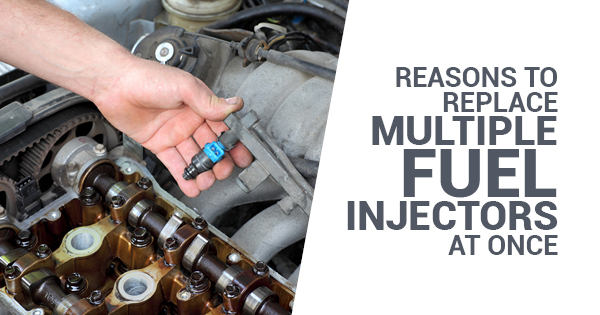Assuming you have changed the fuel injectors on your own:
1. Check for any leaks around the injectors and at the fuel rail. If there are no leaks, move on to the next step.
If there are leaks, make sure all connections are tight and free of debris.
2. Start the engine and let it idle for a few minutes. If it idles smoothly, congratulations!
You’ve successfully changed your fuel injectors.
If you’ve just changed your fuel injectors, congratulations! This is a great way to improve the performance of your vehicle. However, there are a few things you should do after changing fuel injectors to ensure that everything goes smoothly.
First, make sure that you bleed the air out of the fuel lines. This will help prevent any bubbles from forming and causing issues with your injectors.
Next, check all of the connections to make sure they are tight and secure.
You don’t want anything coming loose while you’re driving!
Finally, take your vehicle for a test drive to make sure everything is working properly. Pay attention to how the engine sounds and feels – if anything seems off, bring it back to the shop where you had your work done and have them take a look.
Changing fuel injectors is a great way to improve your vehicle’s performance.
Hard to Start After Replacing Fuel Injectors
It’s not uncommon for your car to have difficulty starting after you’ve replaced the fuel injectors. This is usually caused by one of two things: either the new injectors aren’t compatible with your car’s fuel system, or there’s something wrong with the way they were installed.
If you’re sure that the new injectors are compatible with your car, then the most likely culprit is an improper installation.
Fuel injectors need to be installed in a very specific way in order for them to work correctly, and if even one step is skipped or done incorrectly, it can cause starting issues.
The best way to ensure that your new fuel injectors are installed properly is to take your car to a professional mechanic. They’ll know exactly how to install them so that they work correctly and don’t cause any starting problems.
How to Clean Fuel Injectors
If your car is struggling to start, or if it’s running rough and you suspect that dirty fuel injectors could be the culprit, then it’s time to give them a good cleaning. Fuel injectors are responsible for delivering fuel to the engine, so when they get clogged with dirt and debris, it can cause all sorts of problems. A professional cleaning will cost you around $100, but you can save yourself some money by doing it yourself.
Here’s how:
What You’ll Need:
-Fuel injector cleaner (like Sea Foam)
-A catch pan or bucket
-Protective gloves
-Safety goggles
1. Start by disconnecting the negative battery terminal to avoid any accidents. 2. Locate the fuel rail on your engine and unscrew the cap so you can access the injectors. 3. Put on your safety gear and have your catch pan ready before proceeding.
4. Using a clean cloth or brush, remove any dirt or debris from around the injectors. 5. Next, use the injector cleaner to liberally spray down each injector (be sure to follow the instructions on the bottle). 6. Allow the cleaner to sit for 10-15 minutes before moving on to step 7 .
If you’re working on an older car ,you may want to let it soak overnight . 7 . Using compressed air ,blow out each of the holes in The Injectors 8 .
Reconnect The Negative Battery Terminal 9 .
How to Remove Fuel Injectors
If you need to remove your fuel injectors, there are a few things you’ll need to do. First, disconnect the negative battery cable. Next, relieve the pressure in the fuel system by disconnecting the fuel pump relay and starting the engine until it stalls.
With the pressure relieved, you can now disconnect the fuel lines from the injectors. Finally, unscrew the injectors from their mounting holes and pull them out.
How to Remove Injectors from Fuel Rail
Removing injectors from a fuel rail can be tricky, but with the right tools and a little patience, it can be done. Here’s what you’ll need:
-A socket wrench with the correct size socket for your injector bolts
-An extension for your socket wrench (optional)
-A rag or paper towel
-A catch basin or container to catch any spilled fuel
Begin by disconnecting the negative battery terminal to avoid accidentally electrocuting yourself. Next, locate the fuel rail on your engine. It will be located near the intake manifold, and will have a series of injectors mounted to it.
Using your socket wrench, loosen the bolts that hold each injector in place. Be careful not to strip them, as they are made of soft metal and can be easily damaged. Once all of the bolts are loosened, gently pull on the injectors until they pop out of their seats in the fuel rail.
If they are stubborn, wiggle them back and forth until they come loose. Take care not to damage the O-rings that seal each injector in its seat.
Now would be a good time to inspect each injector for corrosion or other damage that may have caused it to fail.
If everything looks okay, clean off any dirt or grime using a rag or paper towel before proceeding.
Reinstalling new or refurbished injectors is simply a matter of reversing these steps – line up each one in its seat and hand-tighten the bolts before snugging them down with your socket wrench. Reconnect the negative battery terminal, start up your engine, and check for leaks around each injector before giving yourself a pat on the back for a job well done!
Semi Truck Injector Replacement Cost
As a truck owner, you know that maintaining your vehicle is vital to keeping it running properly. One important part of truck maintenance is replacing your injectors when they become worn out. But how much does it cost to replace semi truck injectors?
The average cost of replacing one injector in a semi truck is $850. This price can vary depending on the type of truck, the brand of injector, and the location of the repair shop. If you need to replace more than one injector, the cost will be higher.
Replacing your semi truck’s injectors is not something that you can put off for too long. If your injectors are worn out, it will affect the performance of your engine and could eventually lead to engine damage. That’s why it’s important to keep up with this maintenance task and budget for the replacement cost when necessary.

Credit: www.dieselogic.com
Do You Need a Tune After Changing Fuel Injectors?
If you’ve just replaced your fuel injectors, it’s likely that your car will need a tune. This is because the new injectors will be flowing more fuel than the old ones, and the engine management system needs to be adjusted to account for this change. Otherwise, the engine will run lean and could potentially damage itself.
So if you’ve just swapped out your injectors, take it to a tuner and have them adjust the settings accordingly. It’ll save you a lot of hassle (and money) in the long run.
Do You Have to Program Fuel After Injector Install?
No, you don’t have to program fuel after injector install.
What Happens If You Don’T Program New Injectors?
If you don’t program new injectors, your car will run less efficiently and may eventually not start at all. The reason for this is that the injectors are responsible for delivering fuel to the engine. If they’re not programmed properly, they won’t be able to deliver the right amount of fuel, which can lead to all sorts of problems.
What Must Be Done before Replacing the Fuel Injector?
In order to replace a fuel injector, the first thing that needs to be done is to identify which injector is faulty. This can be done by performing a visual inspection, or by using a multimeter to test for continuity. Once the faulty injector has been identified, it needs to be removed from the engine.
The fuel line must then be disconnected from the injector, and the electrical connector must be unplugged. The old injector can now be replaced with a new one, and everything can be reassembled in reverse order.
WHAT To do AFTER NEW INJECTORS or ENGINE
Conclusion
If you’ve recently changed your fuel injectors, there are a few things you should do to ensure optimal performance. First, check all of the connections to make sure they’re tight. Next, start the engine and let it idle for a few minutes to give the new injectors time to prime.
Finally, take the car for a short drive to make sure everything is working properly. By following these simple steps, you can be sure that your new fuel injectors are up and running smoothly.
